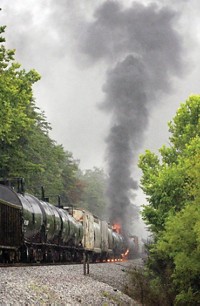Advertisement
Grab your lab coat. Let's get started
Welcome!
Welcome!
Create an account below to get 6 C&EN articles per month, receive newsletters and more - all free.
It seems this is your first time logging in online. Please enter the following information to continue.
As an ACS member you automatically get access to this site. All we need is few more details to create your reading experience.
Not you? Sign in with a different account.
Not you? Sign in with a different account.
ERROR 1
ERROR 1
ERROR 2
ERROR 2
ERROR 2
ERROR 2
ERROR 2
Password and Confirm password must match.
If you have an ACS member number, please enter it here so we can link this account to your membership. (optional)
ERROR 2
ACS values your privacy. By submitting your information, you are gaining access to C&EN and subscribing to our weekly newsletter. We use the information you provide to make your reading experience better, and we will never sell your data to third party members.
Safety
Chemical Spill Slows New Jersey Train Crash Probe
Security: Bridge and the train itself considered as cause for derailment
by Glenn Hess
December 6, 2012
| A version of this story appeared in
Volume 90, Issue 50

An old New Jersey railroad bridge is a factor federal authorities are investigating as they search for the cause of a Nov. 30 train derailment and subsequent chemical leak that sent dozens of people to a local hospital. The accident, in the town of Paulsboro, also prompted the evacuation of some 500 residents, although no one was seriously injured. Investigators are working slowly because of concerns about the levels of the chemical in the air.
At a news conference last week, National Transportation Safety Board (NTSB) Chair Deborah A. P. Hersman said the inquiry is focusing on both the train and the bridge, which partially collapsed in the accident. The bridge was built in 1873 and reconstructed after it buckled in August 2009, derailing 16 railroad cars of coal.
Since the November accident, NTSB officials have been interviewing witnesses and examining inspection records to learn why a Conrail freight train hauling vinyl chloride derailed and dumped four tank cars into Mantua Creek, which empties into the Delaware River near Philadelphia.
One of the derailed cars ruptured, releasing into the air some 25,000 gal of vinyl chloride, a known human carcinogen. The chemical is used to make polyvinyl chloride plastic and vinyl products. Short-term exposure to high levels of the chemical in the air affects the central nervous system and can cause dizziness, drowsiness, and headaches.
Hersman said NTSB would not reach any immediate conclusions about the cause of the latest derailment while its investigators are on the scene.
NTSB investigators will enter the accident site after response crews remove the remaining vinyl chloride from the breached tank car. That work has been slowed because elevated levels of vinyl chloride have been detected in the area.
“It’s important for us to get access to the site because we want to thoroughly access the wreckage, document the condition of the bridge, the track, the condition of those cars,” Hersman said. “We want to make sure we understand how the tank car failed and how the pileup occurred.”



Join the conversation
Contact the reporter
Submit a Letter to the Editor for publication
Engage with us on Twitter